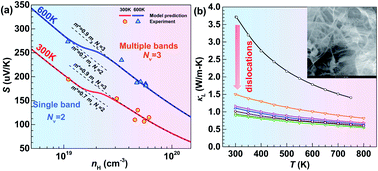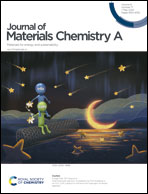Na-doping enables both dislocations and holes in EuMg2Sb2 for thermoelectric enhancements
Abstract
A high conduction band degeneracy (Nv = 6) leads to an extraordinary figure of merit (zT) in n-type Mg3Sb2 thermoelectrics, while the p-type ones show a much inferior zT due to its lower Nv of only 1 owing to the large energy offset (ΔE ∼ 0.4 eV) between the two valence bands. The derivatives of Mg3Sb2, ternary AB2C2 (A = Eu, Yb, Ca, Sr, Ba; B = Mg, Zn, Cd; C = Sb, Bi) Zintls, show a similar valence band structure but with a much smaller ΔE of <0.2 eV, leading to potential convergence of both valence bands for a high overall Nv of 3. This band feature promotes AB2C2 ternaries to be potential p-type thermoelectrics matching with n-type Mg3Sb2 for efficient thermoelectric applications, thus motivating the current work focusing on p-type EuMg2Sb2 thermoelectrics. Interestingly, Na-doping at the Eu site is found to be particularly effective for creating dense in-grain dislocations, which results in a remarkable reduction in lattice thermal conductivity to ∼0.5 W m−1 K−1. Moreover, Na-doping increases the hole concentration up to 6.0 × 1019 cm−3, leading to an effective involvement of multiple transporting valence bands. The synergistic effects of dense dislocations and multi-band transport, both enabled by Na-doping, led EuMg2Sb2 to show the highest zT among known doped p-type ternary AMg2C2 Zintl thermoelectrics.

- This article is part of the themed collection: Journal of Materials Chemistry A HOT Papers


 Please wait while we load your content...
Please wait while we load your content...